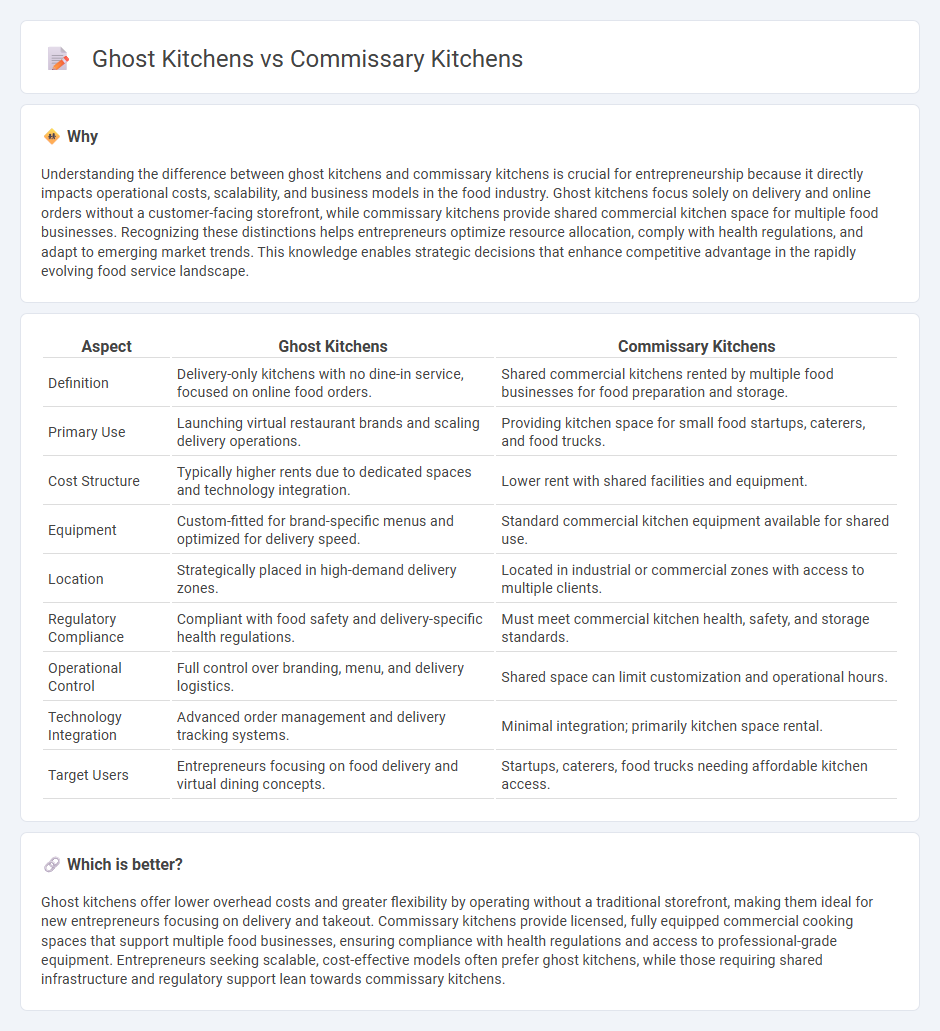
Ghost kitchens operate exclusively for delivery services without a storefront, minimizing overhead costs and maximizing food preparation efficiency. Commissary kitchens provide shared commercial kitchen spaces for multiple food businesses to prepare and store meals, offering a cost-effective solution for startups and expanding brands. Explore the key differences and advantages of ghost kitchens versus commissary kitchens to understand which model suits your entrepreneurial needs best.
Why it is important
Understanding the difference between ghost kitchens and commissary kitchens is crucial for entrepreneurship because it directly impacts operational costs, scalability, and business models in the food industry. Ghost kitchens focus solely on delivery and online orders without a customer-facing storefront, while commissary kitchens provide shared commercial kitchen space for multiple food businesses. Recognizing these distinctions helps entrepreneurs optimize resource allocation, comply with health regulations, and adapt to emerging market trends. This knowledge enables strategic decisions that enhance competitive advantage in the rapidly evolving food service landscape.
Comparison Table
| Aspect | Ghost Kitchens | Commissary Kitchens |
|---|---|---|
| Definition | Delivery-only kitchens with no dine-in service, focused on online food orders. | Shared commercial kitchens rented by multiple food businesses for food preparation and storage. |
| Primary Use | Launching virtual restaurant brands and scaling delivery operations. | Providing kitchen space for small food startups, caterers, and food trucks. |
| Cost Structure | Typically higher rents due to dedicated spaces and technology integration. | Lower rent with shared facilities and equipment. |
| Equipment | Custom-fitted for brand-specific menus and optimized for delivery speed. | Standard commercial kitchen equipment available for shared use. |
| Location | Strategically placed in high-demand delivery zones. | Located in industrial or commercial zones with access to multiple clients. |
| Regulatory Compliance | Compliant with food safety and delivery-specific health regulations. | Must meet commercial kitchen health, safety, and storage standards. |
| Operational Control | Full control over branding, menu, and delivery logistics. | Shared space can limit customization and operational hours. |
| Technology Integration | Advanced order management and delivery tracking systems. | Minimal integration; primarily kitchen space rental. |
| Target Users | Entrepreneurs focusing on food delivery and virtual dining concepts. | Startups, caterers, food trucks needing affordable kitchen access. |
Which is better?
Ghost kitchens offer lower overhead costs and greater flexibility by operating without a traditional storefront, making them ideal for new entrepreneurs focusing on delivery and takeout. Commissary kitchens provide licensed, fully equipped commercial cooking spaces that support multiple food businesses, ensuring compliance with health regulations and access to professional-grade equipment. Entrepreneurs seeking scalable, cost-effective models often prefer ghost kitchens, while those requiring shared infrastructure and regulatory support lean towards commissary kitchens.
Connection
Ghost kitchens and commissary kitchens both optimize operational efficiency for food entrepreneurs by providing shared kitchen spaces that reduce overhead costs. Ghost kitchens focus primarily on delivery-only food services without a physical dine-in space, while commissary kitchens offer licensed, fully equipped facilities rented by multiple food businesses for preparation and storage. This connection enables entrepreneurs to scale quickly and test new concepts with lower financial risk and increased flexibility.
Key Terms
Shared Space
Commissary kitchens provide multiple food businesses access to fully equipped, licensed kitchen spaces within a shared facility, fostering collaboration and reducing individual overhead costs. Ghost kitchens operate solely for delivery and takeout orders, often utilizing shared spaces optimized for streamlined food preparation without dine-in services. Explore the key differences and benefits of shared culinary spaces to determine which kitchen model suits your business needs.
Delivery-only
Commissary kitchens provide shared commercial cooking spaces supporting multiple food businesses with physical locations, while ghost kitchens operate exclusively for delivery-only services without dine-in options. Ghost kitchens optimize delivery logistics and menu scalability through streamlined setups that reduce overhead costs and improve order efficiency via third-party platforms. Explore detailed comparisons to understand which model best suits your delivery-only food service goals.
Food Preparation
Commissary kitchens provide shared, licensed commercial kitchen spaces for multiple food businesses, ensuring compliance with health regulations and allowing safe food preparation under professional standards. Ghost kitchens, also known as virtual kitchens, operate exclusively for online orders without dine-in services, optimizing food preparation for delivery efficiency and menu flexibility. Explore the key differences and benefits of commissary and ghost kitchens to enhance your food business strategy.
Source and External Links
What is a Commissary Kitchen: How Restaurant Operations Use ... - A commissary kitchen is a licensed and fully-equipped shared or dedicated culinary workspace designed for food preparation, catering to startups, established restaurants, and food entrepreneurs with various operational needs.
What is a Commisary Kitchen? How can you benefit from it? - Commissary kitchens provide licensed commercial-grade space with industrial kitchen equipment for food businesses to rent hourly or monthly, helping reduce overhead costs while meeting health regulations.
Commissary Kitchens: Launch Your Food Business with Ease - Commissary kitchens, also known as cloud or shared kitchens, are rented commercial kitchen spaces ideal for food trucks, caterers, takeout/delivery-focused restaurants, and home-based chefs needing fully equipped culinary workspaces.
 dowidth.com
dowidth.com